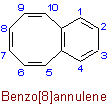
ACD/Name (Chemist Version) offers a standardized set of features for quick and simple generation of IUPAC names, and structures from names. It is a streamlined version of our popular ACD/Name software.
View a full description and pricing on our web store.

R-2.4.1.1 ortho-Fused or ortho- and peri-fused polycyclic ring systems with the maximum number of noncumulative double bonds and which have no accepted trivial or semisystematic name, are named by selecting a component having a trivial or semisystematic name as a principal component and designating the other components as a prefix. The principal component should be a heterocyclic system (if possible) and should include as many rings as possible.Examples to R-2.4.1
The prefixes designated an attached component are formed by changing the terminal 'e' of a trivial or Hantzsch-Widman name (R-2.3.3) of a component into 'o'. In these recommendations,
this final 'o' is no longer elided when followed by a vowel. Contracted fusion prefixes such as 'benzo-', 'naphtho-', and 'anthra-' are used. For monocyclic components other than benzo-, prefix names
such as 'cyclopenta-' and 'cyclohepta-' are used and represent the form having the maximum number of noncumulative double bonds. Locants referring to positions of heteroatoms in component rings are
enclosed in brackets. Further details of the principles of fusion nomenclature are given in Section A and in Section B in the 1979 edition of the IUPAC
Nomenclature of Organic Chemistry .
.
R-2.4.1.2 A polycyclic system which can be regarded as 'ortho-fused' or 'ortho- and peri-fused' and which, at the same time, has other bridges can be named by citing the bridges as nondetachable prefixes to the name of the 'ortho-fused' or 'ortho- and peri-fused' system.Examples to R-2.4.1.1

(see R-2.3.1.2)
Note: A double bond in a bridge is denoted by a locant enclosed in square brackets (see R-9.2.1).Examples to R-2.4.1.2
R-2.4.1.3 There are several methods that can be used to derive names for polycyclic components of fused hydrocarbon ring systems.Examples to R-2.4.1.2
R-2.4.1.3.1 Hydrocarbons consisting of four or more ortho-fused benzene rings in a rectilinear arrangement are named by citing a numerical prefix denoting the number of benzene
rings followed by the term '-acene' with elision of an 'a' .
.
R-2.4.1.3.2 Hydrocarbons consisting of a benzene ring ortho-fused at positions 1,2 and 3,4 to two identical rectilinear arrangement of ortho-fused benzene rings (or to two rectilinear arrangement of ortho-fused benzene rings one of which has one more ring than the other) are named by citing the numerical prefix denoting the number of benzene rings followed by the term '-aphene' with elision of an 'a'.Example to R-2.4.1.3.1
R-2.4.1.3.3 Hydrocarbons consisting of two fused identical monocyclic rings and having the maximum number of noncumulative double bonds are named by citing the numerical prefix denoting the number of carbon atoms in each ring followed by the term '-alene' with elision of an 'a'. The trivial name 'naphthalene' is retained (see R-9.1, Table 20).Examples to R-2.4.1.3.2
R-2.4.1.3.4 Hydrocarbons consisting of a monocyclic hydrocarbon with an even number of carbon atoms ortho-fused on alternate sides to benzene rings are named by citing a numerical prefix denoting the number of benzene rings followed by the term '-phenylene'.Examples to R-2.4.1.3.3
R-2.4.1.3.5 Hydrocarbons consisting of a monocyclic hydrocarbon with an even number of carbon atoms ortho-fused on alternate sides to the 2,3-positions of naphthalene rings are named by citing a numerical prefix denoting the number of naphthalene rings followed by the term '-naphthylene'.Examples to R-2.4.1.3.4
R-2.4.1.3.6 Hydrocarbons consisting of five or more ortho-fused benzene rings forming a helical arrangement are named by citing a numerical prefix denoting the number of benzene rings followed by the term '-helicene'.Examples to R-2.4.1.3.5
R-2.4.1.4 There are several methods that can be used to derive semisystematic names for heterocyclic components of fused ring systems.Example to R-2.4.1.3.6
R-2.4.1.4.1 Heterocyclic ring systems consisting of two benzene rings ortho-fused to a 1,4-diheteroaromatic six-membered monocyclic ring in which the
heteroatoms are different are named by adding the prefix 'pheno-' to the Hantzsch-Widman name of the heteromonocycle (see R-2.3.3.3) .
.
R-2.4.1.4.2 Heterocyclic ring systems consisting of two benzene rings ortho-fused to a 1,4-diheteroaromatic six-membered monocyclic ring in which the heteroatoms are the same are named by adding the replacement prefix for the heteroatom (see Table 3) to the term '-anthrene', with elision of an 'a'. As exceptions, the names 'phenazine' and 'phenomercurine' are retained.Examples to R-2.4.1.4.1
Example to R-2.4.1.4.2



Published with permission of the IUPAC by Advanced Chemistry Development, Inc., www.acdlabs.com, +1(416)368-3435 tel, +1(416)368-5596 fax. For comments or suggestions please contact [email protected]